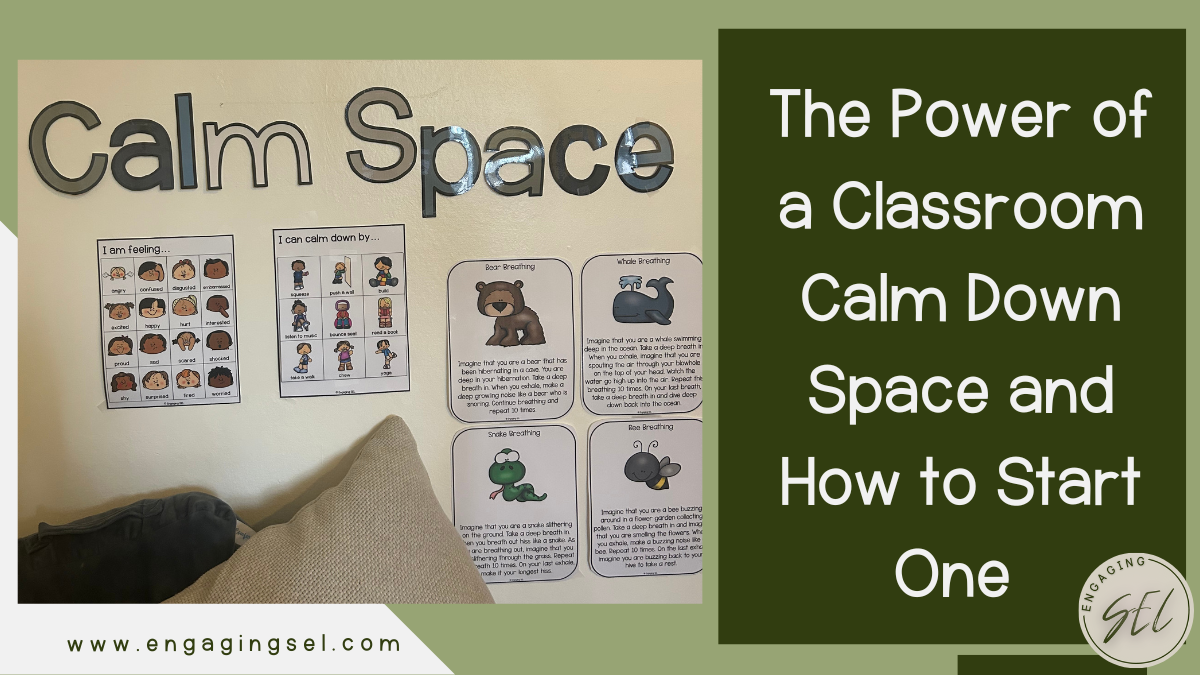
Has this Happened to You?
You are in the middle of what you think is an engaging lesson, students are engaged, and everything is going great when all of a sudden a student erupts out of nowhere. That student is having a full-blown meltdown, other students are staring and the lesson just crumbled into pieces. Instead of teaching you are redirecting that student, trying to figure out what went wrong while the rest of the class watches. This adds fuel to the fire because no one wants to be gawked at when dealing with big feelings. You possibly would be able to de-escalate the child but if not then they might be asked to visit a buddy room or take a break somewhere else. Sounds familiar? I’ve been there so I know how exhausting it is to constantly stop teaching to help students through difficult moments. During my hardest year of teaching, this was my daily. All day long I was putting out fires, assisting students to regulate themselves, and trying to keep the rest of the class on task simultaneously. It was almost impossible. What if I told you I could help you with all of that? Here’s where the calm-down area comes in.
Why use a Calm Down Space?
It is so important to the overall well-being and success of everyone in the classroom to foster a positive and supportive learning environment. This does not just happen overnight. Self-regulation, self-awareness, coping skills, and other aspects of social-emotional learning need to be explicitly taught and practiced by students before they become automatic. Stressful situations come up constantly throughout the day for students and you will not be able to help every student through every situation that comes up AND still be able to teach.
Students need a dedicated space in the classroom to help them manage their emotions, regain their composure and develop their self-regulation skills safely and constructively, A calm-down space in the classroom is a safe, non-punitive area for students to escape stressful situations and help them positively manage their emotions. They can practice the emotional regulation techniques that they were taught to help them respond thoughtfully and calmly to the situation.
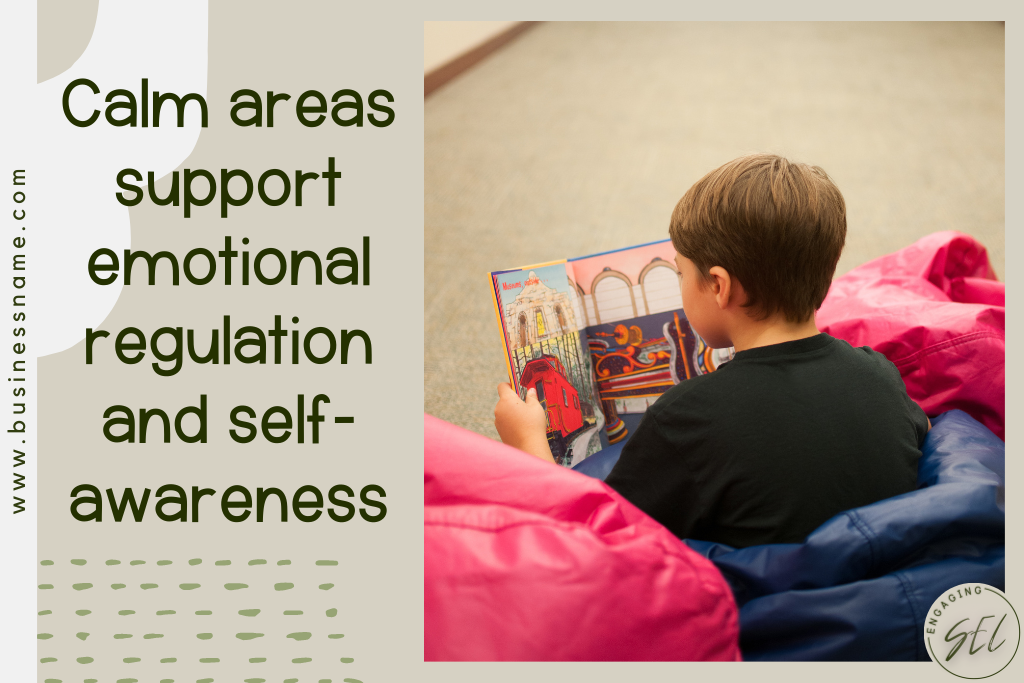
Support Students’ Emotional Regulation
The calm-down area in the classroom is a behavioral intervention to help students address their feelings before they escalate to behavioral issues. This means more time in the classroom, less time spent on learning disruptions, and more time on task for everyone. Students can recognize the signs and signals their body is giving them and work to reflect on their actions and emotions to regulate themselves. This space helps students to identify and understand triggers and supports self-awareness and personal growth. Having this space available to everyone in the classroom supports an inclusive, compassionate classroom culture. It also shows your students that you are understanding and supportive of their emotional needs and gives them a feeling of a safe space where they can work through their emotions without judgment.
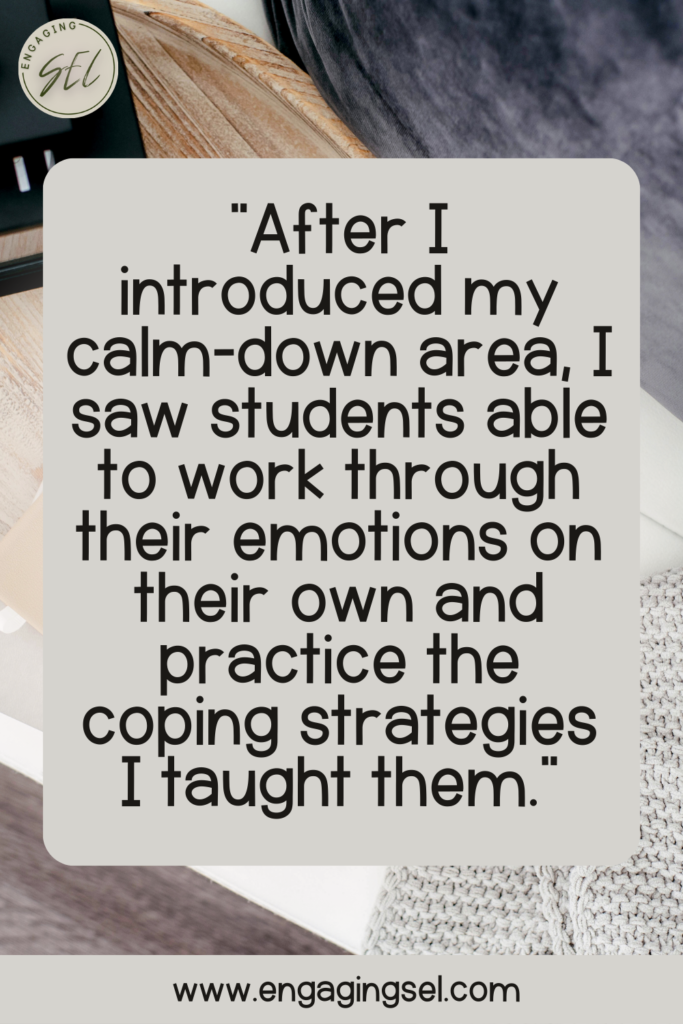
I have seen the benefits of a calm-down space in my classroom firsthand. The first year we came back to the classroom after covid was so difficult. Students had so many emotional needs that were not being met when they were learning virtually. They came back into the classroom unable to self-regulate or manage their emotions and had almost no coping skills. I spent almost all of my day working on social-emotional lessons. After I introduced my calm-down area, I saw students able to work through their emotions on their own and practice the coping strategies I taught them. They were able to regulate themselves after lots of practice and did not always need me to intervene as much. I had students that were able to recognize their triggers, take some time to themselves in the calm-down corner and rejoin the lesson when they were ready. It was a Game Changer!! Here’s how you can transform your classroom community and get this result too.
Creating the Calm Down Area
Appropriate Space
Whatever space you choose to put your calm down area must be easily accessible for all students. It should be a quiet, unobtrusive space in the room that is private and out of the main learning space but can be seen by the teacher at all times. It should be out of the main flow of traffic in the classroom and give a secluded feel while still being a part of the classroom.
Furnishing
Your area should have comfortable seating but you don’t have to break the bank. There are tons of options from expensive to low-budget. Donors Choose is also a great option to help fund your calm down corner but check with your district first to see their rules for crowd-funding.
Bean bag chairs, floor cushions, rugs, carpets, or even a pillow can work. I use my son’s old baby bobby lounger, which is just basically a big pillow but the kids love it! Get creative and find what works for you. You can explore my list of calm-down area furniture on Amazon for ideas.
Calming elements are also important. Soft lighting if possible, plants, mindfulness quotes, and positive affirmations can be great things to include in a calm-down space. I also include sensory tiles and other sensory elements in my calm-down space. Read more about creating a calm classroom environment in my blog post about mindfulness in the classroom.
Tools
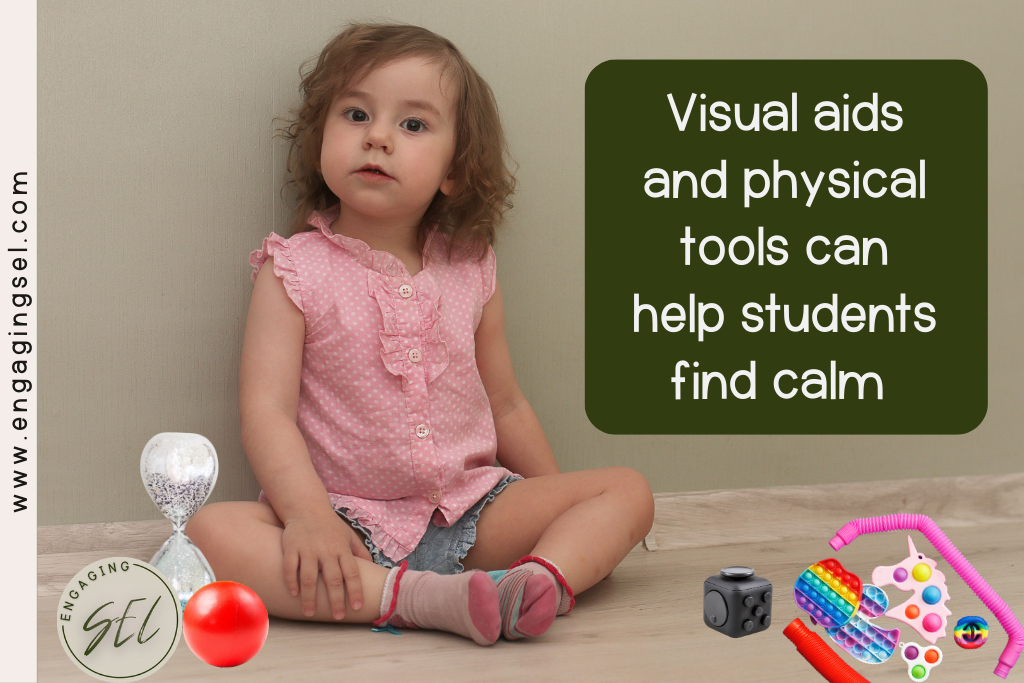
Tools for the calm-down space should be easy for students to use and clean up. They should also be quiet enough that they do not disturb the rest of the students who are learning. Visual aids are wonderful for students to use to find calm such as sensory bottles, sand timers, and bubble timers. Breathing posters and mindfulness activities on task cards can be helpful for students. More physical tools can include stress balls, pinwheels, fidgets, calm strips, puzzles, or thinking putty. The options are endless. Find my favorites for a peace place here. Choose at least one to three tools to start with and you can always change them up throughout the year. Before putting the tools into the calm-down space, be sure to introduce them to the students, show them how to use them, how the tools can help them, and how to clean them up when they are finished.
Emotional Identification
The goal of the calm-down space is emotional regulation, self-regulation, and reflection so the first place to start is helping students identify how they are feeling and why they need to use the calm-down space to start with. To help with this, you can include an emotion identification poster or chart that displays a variety of emotions. Helping students name what they are feeling first can help them decide what tools they might need to help them find calm. An angry student might need something to squeeze or push. An excited student might need some breathing activities to find calm. A sleepy or sad student might need a stuffed animal to hug. Every student is different and their reasons for needing the calm down space will be different too. Helping students be able to identify and express their emotions is an important aspect of the calm-down space.
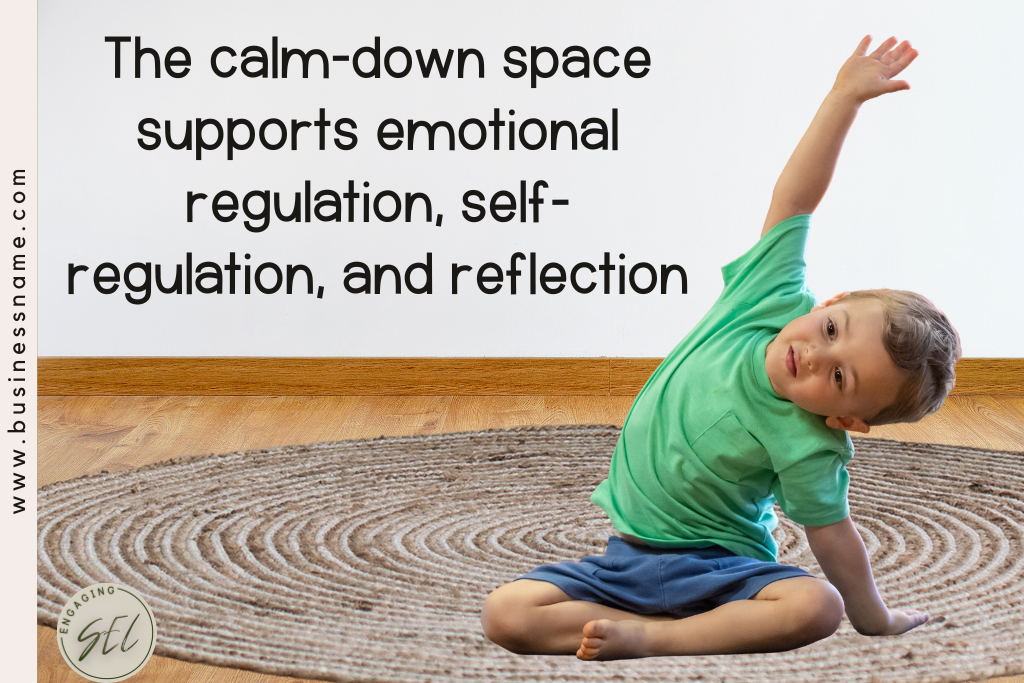
Mindfulness Activities
Along with the tools, mindfulness activities can be included in the calm-down space for students to use. I love to do daily mindfulness activities with my students to help them manage emotions throughout the day so it is a no-brainer to include them in my calm-down space too. Guided meditation apps like Calm, Headspace, or GoNoodle have great videos for kids to use to help with emotional regulation. If you have an iPad or other device students can use in the calm space, this is a great activity to include. Breathing posters and activities are wonderful for students to do as well. Yoga or stretching is great for emotional regulation also. Displaying a few breathing activities or yoga poses in a calm space can give students another option to use to calm down.
Clear Guidelines and Expectations
Before allowing students to use this space on their own, give explicit instructions and directions on how to use the area. Discuss why it is there, how to use it, and when might be a good time for students to use the space. Create simple visual guidelines for using the calm-down space and display when somewhere easy to see. As a class, discuss the consequences of misuse of the space. Explain to the students what to do when they are finished using the space. Decide if there should be a time limit for using the area. Decide how many students will get to use the space at a time. A to-go calm kit or calm folder is a great option if you choose to have only one student in the calm area at a time. Think about how you will organize the supplies and the area and communicate how it should look to the students.
Introduce a Little At a Time
I have made the mistake of buying ALL the fidgets, calm tools, and sensory tools and putting them in my calm area all at once. I put all of the supplies there and was so excited for my students to use them. Every student wanted to use all of the tools at once. It was a disaster! So learn from my mistake. Choose one or two tools to start within your area. Introduce them to the students as a class. Have them all practice using the tool together. All of the students on the carpet passing the tool around at once will help them get over the “new” factor and the excitement of wanting to use it. Show them how to get the tool, how to use it, and how to store it when they are finished. Repeat this process before putting any new tool in the calm space as a choice for the students. This should also be done with any mindfulness activityas well. I use mindfulness activities daily as a brain break for students. After it is introduced and we have practiced it a few times as a class, I put it on a ring and put it in my zen den for my students to use. Check out the mindfulness activities I use here.
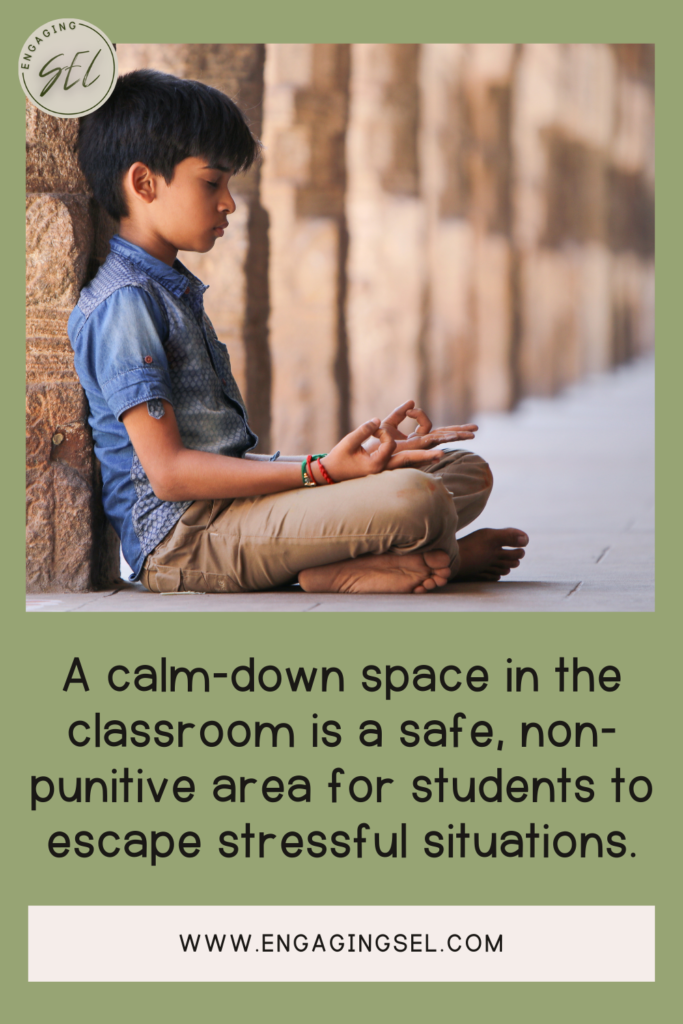
Lead by Example
This part is my favorite piece of advice. I love using my calm-down space in my classroom. Sometimes I sit there during my planning period or my lunch break and just take a few minutes for myself to regroup. I have even used it in front of my students. Using the calm down area yourself shows students that it is okay to take a break to manage your emotions-even for grown-ups. It helps take the stigma away from the area and helps students feel that it is a safe space that ANYONE can use. If the teacher can use it, anyone can use it. Sometimes I might stage this with another teacher coming into my room acting upset and asking to have a break in the calm space. This helps show what it looks like to the students because the rest of us keep learning and working until that adult is ready to go. This is so effective for the students.
Monitor and Reinforce
Observe the students using the area and provide positive reinforcement to the students when they are using the space correctly. Have realistic expectations for them. When I first introduced my calm-down area, I had students using it incorrectly, going back there to play or leaving it a mess. It might, and most likely will, happen but that doesn’t mean the calm-down space is a failure. Take time to reteach, and go over expectations and guidelines as much as necessary. Students need repetition to learn new things so it makes take time for the calm space to run well on its own. Be patient and flexible. This is not a set-it-and-forget-it tool. Just like centers, reading workshops, or anything else, students will need reminders of the expectations from time to time.
If you have a few students who are consistently using the calm area or not following the expectations, you might need to adjust the rules for those students. The Responsive Counselor has a great idea for students who tend to overuse the area by creating a peace pass. Be flexible and remember that what works for one class or one student might not work for everyone else and that is okay!
Get Your Calm Space Set Up in Your Classroom Today
Every classroom needs a safe space for students to recognize and regulate their emotions in a healthy way. Time in the calm space means more time in the classroom instead of being sent out and a stronger classroom community. Helping students identify their emotions and communicate them when necessary leads to stronger communication skills, stronger relationships, empathy, and overall better mental health. If you are ready to start your calm-down area in your classroom go here to check out my done-for-you classroom calm-down kit. Get some ideas and inspiration from these wonderful calm spaces here. I would love to hear how you are starting your own calm-down space and how it is working for your students. Comment below to share!
Mindfully Yours,
Alyssa

